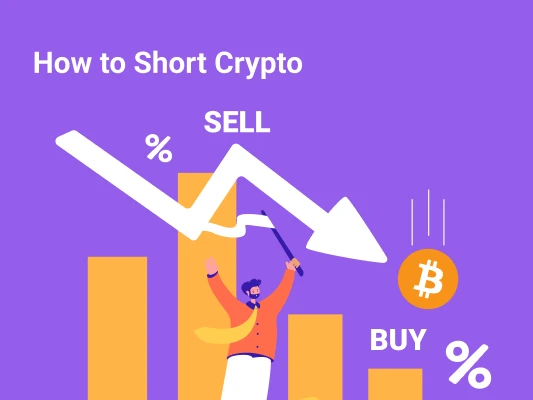
How to Short Crypto [2023 Guide]
Investing is all about profiting when the value increases and losing money when prices go down. However, the short selling or shorting approach is an investment practice that involves anticipating a decline in an asset’s price and betting its price will continue to fall in the future.
While short selling is applied in the stock market, crypto investors can also short Bitcoin (BTC) and other digital assets, mainly due to the cryptocurrencies’ high volatility. Moreover, crypto short selling is an excellent opportunity to earn money during the recent crypto winter or the crypto bear market. How about capitalizing on the gains this crypto winter by trading on the presumption that the cryptocurrency’s price is declining instead of trading in the hopes it will increase?
So, shorting crypto may be the way to go if you’re looking to profit from falling prices. This guide will introduce you to various ways to short Bitcoin or any cryptocurrency of your choice and help you understand the risks before you get started.
Let’s get right to it!
Key Takeaways
- Short selling is a trading strategy based on the expectation of a decline in the price of an underlying asset.
- Crypto short selling is an excellent opportunity to earn money during the recent crypto winter
- You can short crypto through various methods like futures and options, margin trading, etc.
- Short selling carries huge advantages like massive profits but also such inherent risks as the risk of liquidation.
What Is Shorting?
Short selling or shorting is a speculative investment and trading strategy based on the expectation of a decline in the price of an underlying asset. It’s contrary to going long when you’re buying cryptocurrency, expecting it to increase in market value. Short selling is primarily used by experienced traders.
This short-selling strategy refers to an investor’s being “short” of the coins. Crypto investors don’t actually own the crypto asset they intend to profit from, instead, they borrow it from a trading broker and sell it at the current market price in the hopes that the price will continue to decline. Then, they buy the asset when its price drops, making a profit which is the difference between the selling and buying prices.
While shorting crypto can be a handy tool to make money in a volatile market, it can also be risky when the price movement of a particular asset drastically changes over a short period. So, if you’re betting that the asset’s price is going to drop and it rises instead, you stand to lose money by having to buy the underlying asset at a higher price to pay back your broker. The amount of your loss depends on the methods you use to open a short position and how much you have at stake.
How Does Short Selling Work?
Short selling involves borrowing a cryptocurrency from a broker or a cryptocurrency exchange and selling it at the current market price. According to your expectations, the asset’s price will drop over time. If this scenario happens, you buy back the asset at a lower price and repay the debt, making a profit which is the difference between your selling and buying prices.
However, if the crypto asset’s price moves in the opposite direction, i.e., increases, you’ll stand losses, and part of your collateral will be liquidated because you’ll have to repay the debt.
Most major exchanges allow users to short crypto. Cryptocurrency exchanges have various short selling mechanisms, so examine them to choose the one that suits your needs. Additionally, shorting crypto is based on several factors you must consider for taking the right approach, including technical analysis (looking at the past performance of the underlying asset, such as its movement and volume), fundamental analysis (market sentiment, news, trading, adoption, and transaction activity), on-chain data, etc.
Fast Fact
While shorting crypto can be a handy tool to make money in a volatile market, it can also be risky – if you’re betting that the asset’s price is going to drop and it rises instead, you stand to lose money by having to buy the underlying asset at a higher price to pay back your broker.
How to Short Sell Bitcoin?
Crypto markets allow crypto traders to short sell crypto, similar to mainstream markets. Moreover, shorting crypto can be a very beneficial financial strategy in a bear market when the price of Bitcoin or other cryptocurrencies declines. If you want to short Bitcoin or any other cryptocurrencies, you must first borrow it from a broker; here is how it works:
- You want to short one Bitcoin when its price is $30,000 since you expect its price to drop.
- You borrow a Bitcoin from a broker and sell it for $30,000.
- Soon the BTC price drops to $25,000.
- You buy a Bitcoin for $25,000 and return it to the broker.
- Congratulations on making a profit of $5,000 (minus the interest paid to the broker).
Various Methods for Shorting Crypto
Most crypto exchanges support short-selling Bitcoin and other cryptocurrencies, like Ethereum, Litecoin, and Bitcoin Cash, allowing investors to profit from a bearish market. They enable short sellers to trade crypto using margin or derivatives trading. Let’s discuss how to short Bitcoin or some other crypto of your choice in a few different ways.
Margin Trading
Margin trading is a popular method you can use to short crypto. It’s about borrowing money from a crypto exchange to use in trade. Suppose you have $300 in your crypto wallet, but you want to short Bitcoin worth $1300, then the remaining $1000 is on margin or borrowed from the exchange or broker. Then you sell Bitcoin for the current price, and if the Bitcoin price falls to your desired level, you buy it and return to the exchange. As long as you have a margin trade open, you also pay margin interest payments to the cryptocurrency exchange for borrowing money.
Futures Market
Futures and options contracts are derivatives that let you bet on the future price of Bitcoin to profit from price crashes. Some cryptocurrencies, like Bitcoin, have futures markets in which a buyer agrees to purchase a security with a contract, which specifies when and at what price the security will be sold.
In a futures trade, you bet on the price of a security to rise; while selling the futures contract indicates that you expect the price to decline in an upcoming bear market. Bitcoin futures, for example, allow you to buy or sell BTC at a future date. So, when selling a futures contract, you can lock in a price and hope to buy back once Bitcoin’s price drops in the future to earn from its decreased price. However, if the price of Bitcoin increases, instead of decreasing, then you make a loss and even get liquidated. Hence, Bitcoin futures can be very profitable but is equally risky.
In this context, you can short Bitcoin by purchasing contracts that bet on a lower price for the cryptocurrency. The futures contract can expire between a quarter and a full year. However, Bitcoin futures and other crypto futures contracts also have perpetual futures in which the contract doesn’t expire after a quarter or a full year.
You can short Bitcoin futures on the Chicago Mercantile Exchange, the world’s largest trading platform for derivatives.
An options contract accomplishes the same thing as futures but grants you the right but not the obligation to not buy or sell the underlying security at a pre-determined price by a set expiration time.
Contract for Differences
Contract for Difference (CFD) is a method of shorting Bitcoin or other underlying assets based on the difference between open and closing prices for settlement. With Bitcoin CFDs, you can bet on the decline or increase in Bitcoin’s price without having to own actual Bitcoin. You must deposit a part of the margin account’s fund as collateral to guarantee that you’ll be able to buy the crypto at the particular price you’re betting on.
Suppose you’re shorting Bitcoin using Bitcoin CFDs. If the price of Bitcoin is $10000, and you’re expecting the price to fall to $8000, then if the price of Bitcoin falls to $8000, the contract will be executed, and you’ll earn a profit minus the fees. However, if Bitcoin’s prices rise, you’ll end up making a loss. The advantage of CFDs is that they have a flexible settlement tenure, unlike the Bitcoin futures.
Inverse Exchange Traded Products
Exchange-traded products are a new way to short selling Bitcoin assets as they are only available for Bitcoin currently. Traders can take a short position on BTC using these products on Bitcoin exchanges and earn profits when the price declines.
Binary Options Trading
You can also short crypto using binary options trading. Bitcoin binary options allow you to bet on the price of Bitcoin falling within a specific time frame. If the price of Bitcoin falls during that time frame, you’ll earn a profit.
If you wish to short Bitcoin, you will execute a put order to be able to sell the currency at today’s price, even if the price drops later on. Put options allow you to sell the underlying asset when the contract expires. The advantage of using binary options trading is that you can limit your losses by choosing not to sell your put options, thereby limiting your losses to the price you paid for the put options.
This method of shorting crypto is akin to betting on the price and doesn’t involve borrowing or lending. If you predict the price to fall, and the prediction comes true, you’re considered to be “In the Money” and making a profit. If the price prediction doesn’t come true, you are “Out of Money,” and your investment is lost.
Binary options trading is available through some offshore exchanges.
Crypto Shorting Pros
Shorting crypto has numerous advantages for experienced traders, such as:
Hedge Against Price Decline
When you invest in any stock or cryptocurrency, you expect the price to rise to make a profit. However, the markets don’t always go up – they have bearish and bullish cycles. Hence, if you’re investing in cryptocurrencies to make profits in the long run, you can still short crypto to use it as a hedge against a price decline. A short hedge helps you take a short position to protect against a decline in the price of their long positions.
Benefit from Market Volatility
Crypto markets are more volatile than traditional markets, however, you can take advantage of the volatility and make a profit even when the asset reaches a lower price by shorting crypto.
Using Small Bets to Win Big
When you short crypto using leveraged trading, you only have to make a small deposit to gain exposure to the full trade value. Leverage amplifies your purchasing or selling power, enabling you to trade with more money than you actually have.
Crypto Shorting Cons
Now, let’s have a detailed look at some of the major risks involved in short selling crypto.
Limitless Losses
When you short crypto, you’re likely to make huge gains. However, your losses can also be limitless if the asset’s price keeps rising instead of declining.
Bear Traps or Short Squeezes
Bear traps or short squeezes occur when market makers increase prices so that the short sellers end up making losses. A bear trap is a technical pattern in which the price dips or starts falling, then quickly reverses upwards. It’s a trap since it encourages traders to short sell, expecting further decline in prices. However, buyers create demand and increase asset prices.
Liquidation Risk
You must maintain a margin ratio in your crypto wallet when you short crypto. If your losses become too high and you cannot maintain the required margin, the chances of losing your entire capital increase. This is known as a liquidation event, and the funds in your wallet are transferred to the exchange.
Requirements for Margin Accounts
You must follow strict requirements to open a margin account on crypto exchanges. Crypto traders must fill in a questionnaire and/or have cash or securities in their accounts to access a margin account.
Tips for How to Short Crypto
The risks associated with shorting crypto are high, but you can take the following measures to safeguard your short positions such as:
- Use a stop-loss to help minimize your losses and automatically close the trade.
- Don’t chase every price movement; ensure only to enter trades when market signals are clear.
- Risk only the amount you can afford to lose.
Conclusion
Shorting crypto is a great way to make money, especially in the crypto winter we’ve been facing for over a year. You can use short to benefit from the lower price of an asset of your choice and multiply your profits with leverage. However, consider the inherent risks of short selling crypto before making a decision. Moreover, crypto shorting is only suited for advanced traders after they perform their due diligence.
If you’re just interested in buying and selling crypto, you can also learn how to buy crypto with a credit card.






